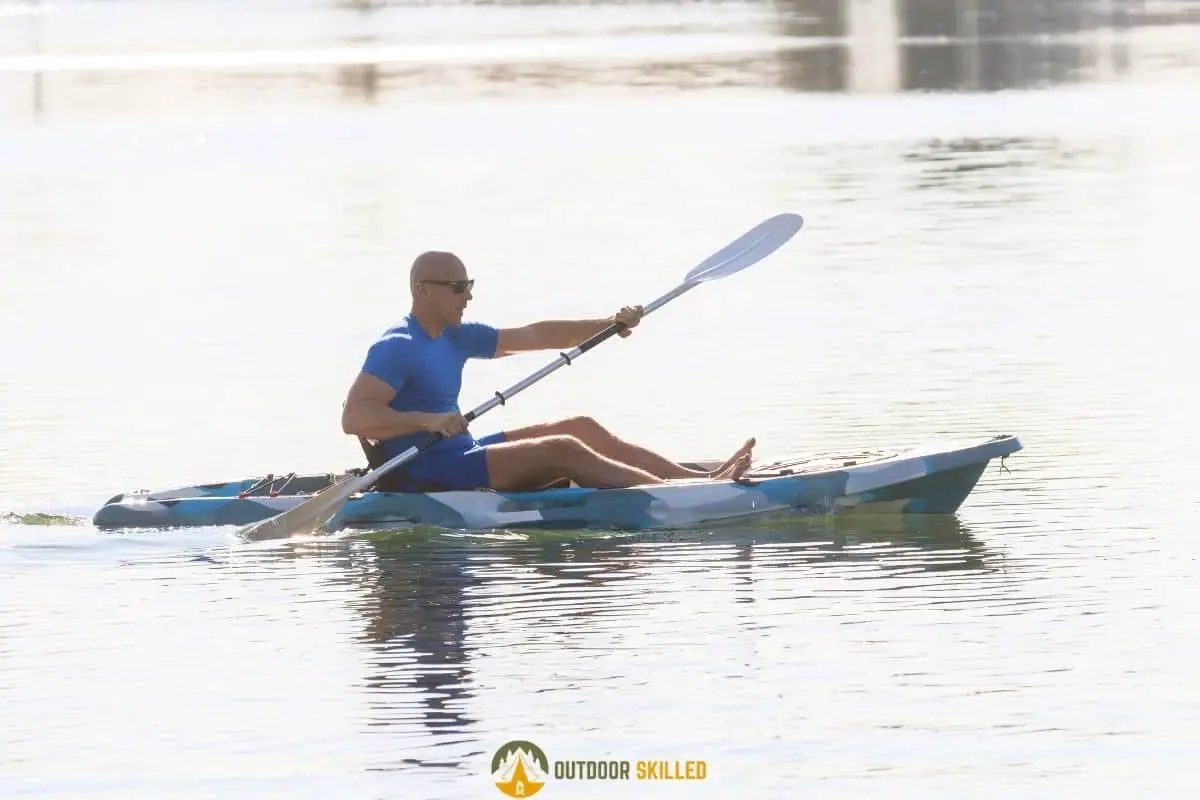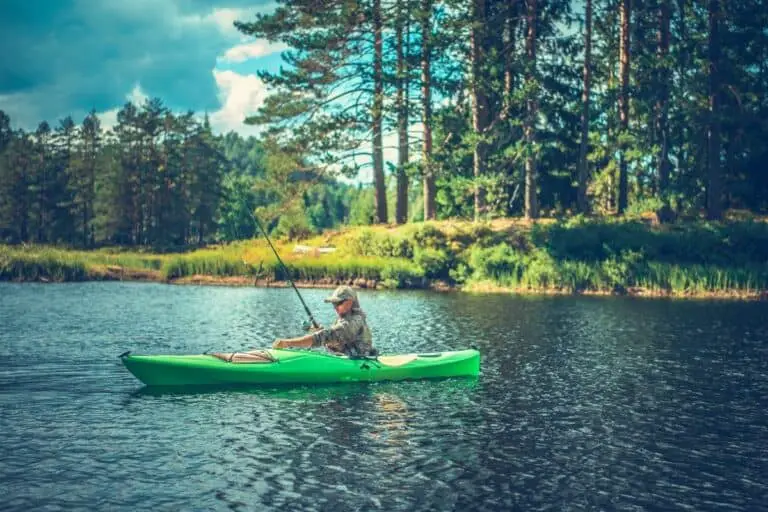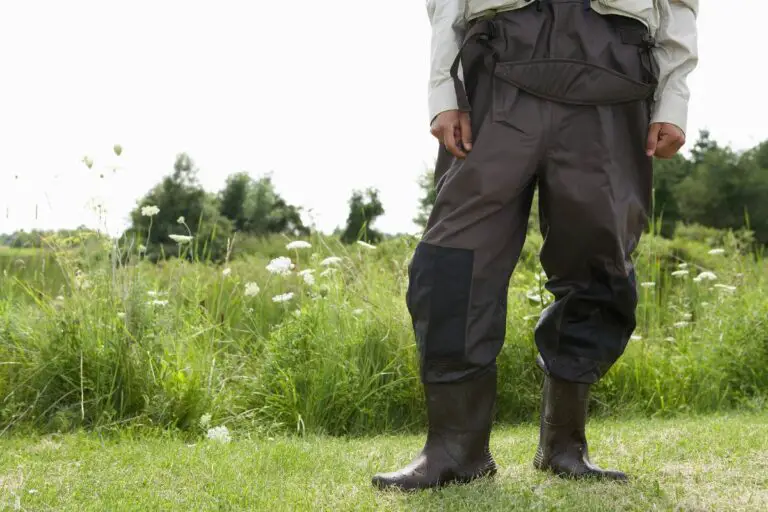How to Stay Dry in a Sit-on-Top Kayak? 9 Tips that Always Work
When you are paddling in a sit-on-top kayak it can be challenging to remain dry, but it’s not completely impossible.
So, how do you stay dry in a sit-on-top kayak? The best way to stay dry in a sit-on-top kayak is to dress in clothing that is water-resistant and stay away from cotton material. You can also try to make your paddle strokes more shallow to reduce splashing and avoid paddling on rainy or windy days.
Keep reading for more tip on how to stay dry in a sit on top kayak and the best methods to get water out of your kayak and make it more stable
You can also check out my recommended budget Kayaks here that offer crazy-good value for the money.
Table of Contents
The Basics of Sit On Top Kayaks

Before getting into how to stay dry when kayaking in a sit on top, you need to learn the basic properties of sit on top kayak.
Sit-on-tops (SOT) are built without a cockpit which allows the paddler to sit right on top of the kayak deck instead of being seated inside the kayak or below the water level.
Because of the lack of a cockpit, there is no way to stop water from splashing up onto the paddler’s body, and with each splash, the paddler will get more and more wet, so it’s much harder to stay dry when paddling in a sit-on-top kayak.
Another important property of sit on top kayaks is that they’re manufactured with four holes in the bottom known as scupper holes. The scupper hole’s main purpose is to drain water that comes on to the deck to stop it from pooling underneath the paddler.
Why Is It Important to Stay Dry When You’re Kayaking?
Kayaking is a water sport, so getting wet is almost inevitable. While most kayakers do not mind getting wet, there’s always the risk of getting hypothermia.
Hypothermia is a state where your body temperature drops below 35°c. The reason it happens is usually a combination of several variables including the water-air temperature, amount of exposure, and wind speed.
Hypothermia doesn’t just occur because you have been submerged in water. It can also happen when the outside temperature is warm and you’ve only experienced a few splashes of water.
It can be life-threatening so in order to minimize the threat and protect yourself, you need to keep yourself as warm and dry as possible.
There are some tips you can follow before you head out onto the water to help keep dry. Let’s check those out:
9 Tips To Stay Dry In A Sit On To Kayak
- Make sure you’re wearing the proper clothing
- You need to wear clothes that are suited for cold weather paddling. Even a few splashes of water from a boat wake or a light shower can make a dramatic difference.
- Try to stay away from materials that aren’t water-resistant especially cotton as it retains water and reduces your body temperature. Jeans are also very inappropriate to kayak in and they can constrict your movement.
- Instead, go for cold weather apparel that is designed specifically for paddling. This includes dry suits for extreme conditions and base layers.
- A drysuit is like a wetsuit for diving but it fits more loosely than a wetsuit and allows you to wear more insulating layers underneath it. They are made to be water-resistant so they can keep you really dry and they can also trap heat inside to keep you warm.
- Underneath a drysuit, you can wear base layers like thermals or lightweight clothing. You can also add gloves and a waterproof coat to help minimize your exposure to water.
- It’s also a good idea to bring a spare set of clothes in a dry bag in case you get extremely wet so you have something dry to change into.
- Optimize your paddling technique
- Water can splash into your kayak mainly because of how you use your paddle blades. Try to change your paddling technique to be more clean, precise and less aggressive.
- Paddle at a lower angle
- Avoid driving your paddle blade vertically into the water. Instead, drive it at a shallow angle so the blade on the opposite end of the paddle doesn’t go over the kayak and drip into the cockpit. It will make you travel slower but it will keep you drier.
- Be more aware of your paddle blades.
- In order to avoid the initial splash when your blade enters the water you need to make your paddle strokes more precise and position the opposite blade in the air in a way that doesn’t throw water on your body when you’re stroking.
- Use paddle drip rings
- Paddle drip rings are attached to the shaft of your paddle on the outside of where you position your hands. Their purpose is to keep excess water from going down the shaft and onto your clothes.
- Plug the kayak’s scupper holes
- Scupper holes are normally used to help drain out the water from your kayak
- It’s a good idea to invest in scupper plugs to plug these holes, especially around your seat. You can also keep the scupper plugs closest to your feet open to allow any water that enters your cockpit to drain.
- Bring a kayak sponge and bilge pump
- Although sit on top kayaks have scupper holes, it’s a good idea to bring a kayak sponge and a bilge pump to remove water from your kayak faster than the scupper holes allow.
- Try to enter your sit-on-top kayak as carefully as you can
- The initial force of entering your kayak drives more water up the scupper holes and into the boat which leads to getting your clothes wet immediately.
- Avoid going paddling when the weather is bad.
- Make sure to check the weather conditions before any trip and avoid paddling on rainy or windy days.
- That is because rain will cause your body to be soaked from the top down as well as make the inside of your boat really wet. The wind will also result in driving more water up through the kayak’s scupper holes and into your cockpit.
How Do You Get Water Out of a Sit On Top Kayak?
The main method is to drain the water through the scupper holes. If you’re using scupper plugs in the holes, you can easily remove them and the water will drain away on its own.
Some kayaks are also fitted with a drain plug to expel water from the hull’s area. You need to remove the plug and tipping your kayak upward to let the water drain. However, make sure to return the plug before you use your kayak again.
Although scupper holes are normally effective at keeping water out of your kayak, sometimes they may not be enough. There are some other methods that can help you expel water out of your kayak:
Bilge Pump
This is a tool that is designed to manually pump water out of the kayak’s interior at a quick rate, which can be useful in the event of a capsize. They’re built to be easily stored since most kayaks don’t have big storage space.
There’s also the option of using an electric bilge pump if you don’t want to manually pump out the water. But keep in mind that electric bilge pumps are considerably more expensive.
Sponge
This kind of sponge is not the same as a typical dish sponge. It’s designed to maximize water absorbance by clearing out high amounts of water in the shortest time possible.
How to Make You Sit On Top Kayak More Stable?
There are two types of stability when it comes to kayaking:
- Primary stability – which is the kayak ability to remain stable when it’s at rest. This means you have the ability to move without the kayak emphasizing your movement.
- Secondary stability – which is the kayak’s ability to remain stable when it’s moving or leaning.
By understanding the factors that affect the stability of your kayak, you improve its stability.
Factors That Affect The Stability Of Your Kayak
- The hull’s shape – The way the hull of your kayak is shaped should be suited to its intended use. Flat hulls are more suited for calm waters where the kayak can stay stable on its own. However, it will be unsuitable for rough currents or against strong wind.
- The width – Generally, the greater a kayak’s width, the better its buoyancy and the less likely it will be tipped or flipped over.
- The weight distribution – The weight distribution of the people and gear in the kayak will directly affect its stability. There shouldn’t be any amount of excessive weight in one area of the kayak.
3 Tips To Increase The Stability of your Kayak
- Adjust your seat to a lower height – By lowering your seat, you can create a stronger center of gravity. This will help improve the stability of your kayak and make you feel more secure.
- Balance the weight distribution – Make sure to distribute your gear evenly throughout the kayak by keeping the weight balanced in front and back, as well as side to side.
- Invest in a stabilizer – Stabilizers feature long arms which are attached to a flotation buoy on one or both sides of your kayak to help create more stability. They can be attached temporarily and removed as you become more experienced.
Related Questions
Can I wear flip-flops to kayak?
No, flip flops are usually not recommended to wear when kayaking, as they can easily come off your feet in the water and their soles are too slippery. It’s better to wear shoes that will stay on your feet. A water bootie or water shoe is a more suitable choice for kayaking.
How Can You Use Scupper Plugs?
The way to use scupper plugs is very simple. All you need to do is push the rubber or plastic plugs in the scupper holes. There are also some models of scupper plugs that need to be screwed in the holes. The short strings that the plugs are manufactured with allow you to easily pull them out if you need to drain water out of the kayak.
Helpful Resources
Hypothermia during sports swimming in water below 11°C
Medical Aspects of White-Water Kayaking
Science and Medicine of Canoeing and Kayaking
If you like this article, please share it or pin it, you can find the share buttons below. We will really appreciate it ❤️





![Which Is Easier: Canoeing Or Kayaking? [Pros & Cons]](https://outdoorskilled.com/wp-content/uploads/2021/11/canoe-vs-kayak-768x512.jpg)

![The 6 Best Kayak Shades and Canopies [Real-Life Tests, 2023]](https://outdoorskilled.com/wp-content/uploads/2021/07/best-kayak-shades-featured-768x512.jpg)
